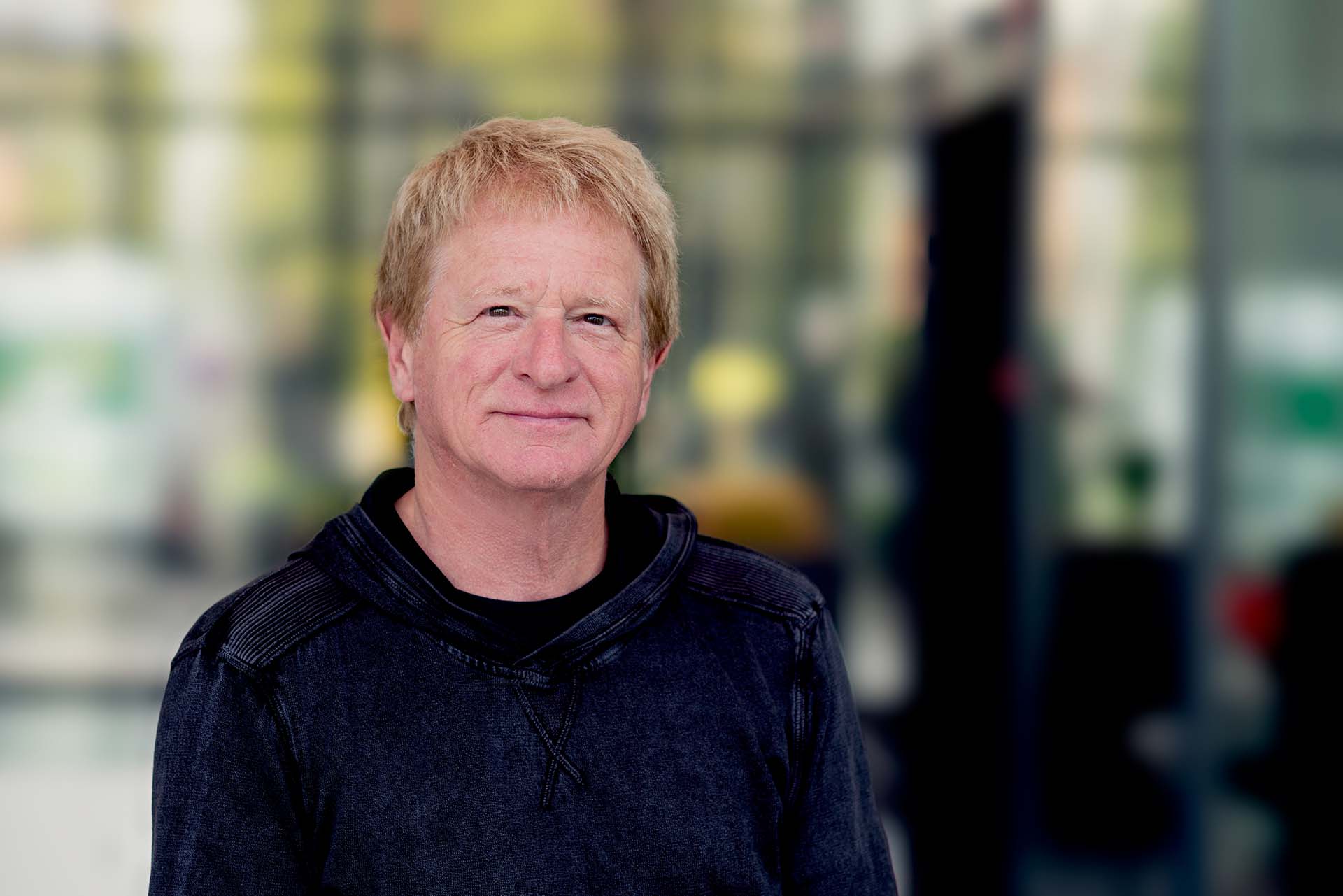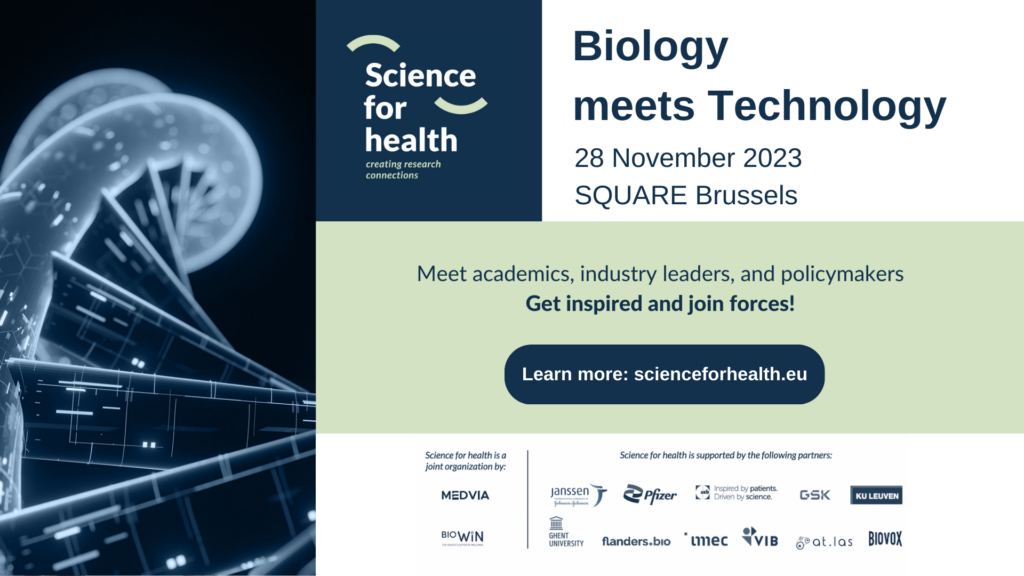This article was part of a series on ‘Biology meets Technology’ in the lead-up to Science for health 2023, where Prof. Jan Rabaey will open the day with a keynote talk on the topic. Header image: Jan Rabaey (credit: Fred Loosen)
Q: Has there been a central theme to your research over the years?
Jan Rabaey: “I’ve been interested in electronics my whole life – making them smaller and creating systems that enable interactions between people and technology. When I first started out in the 1980s, at KU Leuven and then at Berkeley, there was an electronics revolution taking place: people were figuring out how to send digital signals over wireless connections. It was all new, and incredibly exciting! I distinctly remember seeing the first digital telephone slim enough to slip into a pocket and being blown away by the implications. It was clear to me that that the availability of wireless technology would change the world and the way we interact with each other.
“We built a device called the InfoPad… This eventually helped to inspire Apple’s iPad.”
“In the early 90s, inspired by this, my lab group started exploring the question: if wireless connectivity was everywhere and unlimited, how would you build a computer? The answer we came up with is that you wouldn’t: the computing would be done somewhere else, and what you would need instead is a simple device to tap into information elsewhere. Based on this concept, we built a device called the InfoPad: a simple user interface; basically just a screen that was wirelessly connected to servers in the backbone (what we now call the internet, or the cloud). This eventually helped to inspire Apple’s iPad.
“The next challenge our lab tackled was: can we make things smaller? We started toying with the idea of miniature sensors, connected by a wireless network, and what we could do with them. At the time, this was considered a really niche pursuit, but the smaller these sensors got and the more of them connected in a network, the more useful they became. Nowadays, there are these types of sensor nodes in just about everything, forming the Internet of Things (IoT) – from smart phones, to watches, cameras, fridges, and self-driving cars.”
Q: What is your lab currently working on?
Jan Rabaey: “For the past 15 years, my lab has been creating devices that can interface between biology and technology. We’ve been making sensors that are so small that they can talk to a biological cell; nanoscale devices that can be used in healthcare. Our main focus has been on brain-machine interfaces, where we have created chips that wirelessly connect neurons to computers. The aim is for people with physical disabilities to be able to control an external device – like a screen, or a voice generator, or wheelchair – with their mind. Elon Musk’s company Neuralink is currently taking this technology further into human clinical trials.
“The aim of all our research is bringing technology closer in line with the way our body actually works.”
“We’ve also created implantable “neural dust” controlled by ultrasound, which is being developed by Iota; a Bay Area company recently bought by the Japanese pharma Astella. And we’re working on smart prosthetics that can use AI to predict what movement you’re intending to make. It’s a flexible interface that can wrap around your arm, for example, measuring the signals being sent from your nerves to your muscles, and use machine learning to help you move a prosthetic hand to pick up a glass, or open a door, or tie your shoe, without actively thinking about it.
“The aim of all our research is bringing technology closer in line with the way our body actually works. It’s a very exciting space: there are so many new ideas and devices popping up that will change healthcare going forwards. We try to surf that wave of progress, and for the last few decades have been a part of a lot of breakthroughs. But of course not everything is predictable, and you never know exactly how the future is going to shape up!”
Q: Have you witnessed a tech breakthrough that really surprised you?
Jan Rabaey: “I think what has happened over the last ten years in artificial intelligence and machine learning is staggering. This field has been crawling forward for the last 60 years, but then suddenly it has skyrocketed! Where it will now lead to is entirely unpredictable, but it is already changing how we understand and build things. It will have huge impact in healthcare, not only at the patient level, but also in improving our understanding of basic biology through things like protein folding.
“Whether we’re talking about a robot, or a self-driving car, or a drone, these systems are starting to behave more and more like organic entities.”
“Another trend I have found myself astounded by is the increase in interaction between autonomous machines and the physical world. Whether we’re talking about a robot, or a self-driving car, or a drone, these systems are starting to behave more and more like organic entities. A person senses their surroundings, forms a mental representation of reality in their brain, then uses motor function to shape that environment. In the same way, robots collect signals, process them, and are increasingly able to decide upon and physically execute a course of action to change the world around them. It is biomimicry: the convergent evolution of people and machines.”
Q: What do you think will be some of the biggest challenges in the coming years?
Jan Rabaey: “One of the most important considerations in this field is to build something that is usable in daily life. Any new device has to be completely safe, secure, and helpful to the person using it. The second consideration, related to this, is longevity. If you create a device that is going to be implanted in a patient, it needs to last for a long period of time. We’ve already seen cases where devices have been implanted, but then the company responsible for the technology has ceased to exist. This happened with a company that developed a retinal implant – a tiny camera in the eye feeding signals directly into the optic nerve – which restored vision to blind patients. It’s incredible technology, but the company went under a few years ago, and patients were left with useless implants. This type of scenario is obviously completely unacceptable, and we need to ensure that devices are long-lasting in terms of both technology and other supporting factors.
“Finally, you have the critical issue of ethics and acceptance. It is a very thin line between a healthcare device and an augmentation, for example. Take the retinal implants: we already have the technology to install these devices with the additional ability to detect ultraviolet or infrared, expanding vision beyond what a human is normally capable of perceiving. We could also put sensors on the back of your head, so you could sense what’s happening behind you. There are many examples of these kinds of real-life augmentations that are already possible with the technology we currently possess, but that would change our basic capabilities as a human.
“There’s no closing Pandora’s box, so the important thing is for us to consider the ethics of new technologies before they have actually been developed.”
“Just because you build the technology doesn’t mean people will accept it. A few years ago, Google had a historic flop with ‘Google Glass’ – when they unveiled their new product, people were very uncomfortable with the idea of other folks walking around with glasses that could continuously record and identify you via face recognition. The backlash was huge, and ultimately led to Google discontinuing the line.
“However, that technology still exists. Things like that may be gone for a bit, but they will be back. There’s no closing Pandora’s box, so the important thing is for us to consider the ethics of new technologies before they have actually been developed. As scientists, we are often so caught up in the excitement of what might be possible that we fail to stop and think about the fact that the new tech could be used in a negative way as well. It is our responsibility to build devices in such a way that we minimize the potential for harm. And we’re not going to be able to do that on our own – it’s really the whole community that has to decide on these kinds of ethical questions.”
Q: What do you think the future will look like in terms of people and technology?
Jan Rabaey: “I think ultimately we will get more and more used to that vision of humanity and technology operating in unison. A lot of people are scared that technology will overtake them; that AI and machine learning will lead to machines ruling us. I don’t think that will happen. Humanity cannot stand still – the technological advances will happen. We will build more powerful machines, and we will put artificial intelligence everywhere. But I think this will be a joint journey: a convergence between biology and technology, between people and machines.
“We will build more powerful machines, and we will put artificial intelligence everywhere. But I think this will be a joint journey: a convergence between biology and technology, between people and machines.”
“And yes, that will change what we are as humans. But think about the impact that technology has already had on humanity: it’s humongous! Since the introduction of the smartphone, we have been reprogramming our brains. Certain things that we used to do, like remembering phone numbers and dates, are basically gone from our primary (organic) memory and into our secondary (digital) memory. People already interact with phones as an extension of themselves and an enhancement of their natural capabilities. Is that a dystopian cyborg vision of the future? I don’t think so.
“As to the computers themselves, I think that the line between organism and machine will become increasingly blurred. For instance, we’re currently working together with VIB-KU Leuven on a project called ‘brain on a chip’ where we’re building a circuit made of electrodes and neurons. The work is currently being used as a model for dementia research, but the potential of this type of artificial/organic neural network may be huge. A human brain is, to this day, the most efficient computer in existence – although there are chips with more transistors, nothing even comes close to the energy efficiency with which we operate our 86 billion neurons. Building organic computers by merging electronics and neurons is still the stuff of science fiction and would raise a heap of ethical questions. But even the potential is tantalizing. The possibilities at the intersection of biology and technology are vast and exciting!”
Interested in the topic of ‘biology meets technology’? Then join Prof. Jan Rabaey in attending Science for health on 28 November 2023 in Brussels!



